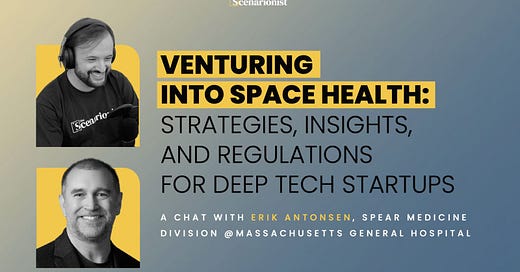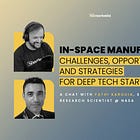✨ This is a Free Edition of The Scenarionist. To enjoy the full experience, become a Premium Member!
Welcome to the 66th edition of Deep Tech Catalyst, the channel by The Scenarionist, where science meets venture!
Space is no longer the exclusive domain of governments. As commercial players accelerate their efforts in low Earth orbit and beyond, the question is no longer if humans will live and work in space—but how we’ll keep them healthy while doing so.
In this episode, we explore the cutting edge of space health innovation with Erik Antonsen, Associate Physician and Member of the SPEAR Medicine Division in the Department of Emergency Medicine at Massachusetts General Hospital. With deep experience at the intersection of medicine, engineering, and space systems—including a past role managing human system risk at NASA—Erik offers a front-row view into the challenges and opportunities of building the future of healthcare... in orbit.
Together, we dig into:
The current state and future vision of human spaceflight, from ISS to Mars.
The unique physiological risks astronauts face—and why commercial space demands new health strategies.
What it takes to bring a wearable health device from lab to launch.
How founders can navigate the complex regulatory landscape of dual-use tech.
The emerging role of personalized medicine in space.
Whether you're a founder building dual-use medical tech, an investor exploring frontier health markets, or simply fascinated by the evolving space economy, this episode sheds light on how innovation, venture, and science come together—beyond Earth's atmosphere.
Let’s launch in! 🚀
✨ For more, see Membership | Partnership | Deep Tech Briefing | Insights
KEY INSIGHTS FROM THE EPISODE
🚀 Why Space Health Today?
The human spaceflight industry is currently experiencing a period of rapid transformation—perhaps the most dynamic shift since its inception. For over six decades, space exploration was almost entirely in the hands of governments. Agencies like NASA, the European Space Agency, and Roscosmos not only funded but also operated nearly every mission that put humans into space.
That reality began to shift dramatically in 2020. When SpaceX successfully launched a human crew to the International Space Station, it marked the first time a commercial company had achieved such a feat. This milestone didn’t just demonstrate technical capability—it fundamentally altered the structure of the industry. For the first time, non-governmental entities were flying people to space, both in collaboration with national agencies and entirely on their own. Missions like Inspiration4 and Polaris Dawn are notable examples of fully private spaceflights carried out by SpaceX.
A Moment Reminiscent of Early Aviation
The industry today bears a striking resemblance to the early days of aviation in the 1920s. Back then, air travel was largely limited to wealthy thrill-seekers—barnstormers who could afford to take to the skies. Yet from that niche market emerged the global aviation network we rely on every day.
We’re at a similarly early stage in the development of routine human spaceflight. That’s part of what makes this moment so exciting. But it also brings a host of new challenges, especially when it comes to supporting human health and performance in space.
Understanding the Human Body in Space
Living and working in space isn’t just about launching rockets—it’s about understanding how the human body responds to entirely new environments. Despite two decades of continuous habitation aboard the International Space Station, the total number of people who have experienced space is still under 700. That’s a very small data set, which means that much of what we know about the effects of microgravity and radiation on the human body is still evolving.
One of the biggest physiological challenges is that space seems to naturally “decondition” the body. In a microgravity environment, muscles and bones aren’t used the same way they are on Earth. Over time, the body interprets this lack of stimulation as a signal that it no longer needs to maintain strength or density. Calcium is reabsorbed from the bones; muscle mass, especially in the legs, begins to shrink.
To date, astronauts have been selected from a highly vetted, extremely healthy population. But as spaceflight becomes more commercialized—especially with the rise of space tourism—that won’t always be the case.
Companies will need to accommodate people with a wider range of physical conditions, and that raises important questions, including:
How can we monitor how someone is adapting to space?
How can we distinguish between healthy adaptation and the early signs of illness?
And how do we ensure people can function effectively in such a demanding environment?
The Technical Side of the Challenge
Beyond the human aspect, spaceflight poses significant technical and engineering limitations. Historically, it has been incredibly expensive to send anything into space—on average, around $10,000 per kilogram to reach low Earth orbit. That price is finally beginning to decrease, and it’s this shift that has enabled the commercial space sector to emerge.
Even so, space remains a constrained environment. Mass, volume, power, and data bandwidth are all limited resources. We’re not operating in the flexible, high-capacity environment of Earth-based cloud computing. Every payload must be carefully optimized to fit within strict parameters.
Although we’re making progress, we’re not yet at a point where materials, data, or energy can be transported to and from space as freely as we might like. That reality imposes a design framework that engineers must work within—and all of it is ultimately in service of one goal: supporting human life and work in space.
SEE ALSO:
🏥 Reimagining Healthcare in Space
As human spaceflight becomes more commercialized and inclusive, the approach to astronaut health is undergoing a quiet but powerful transformation. In the past, the focus was on selecting the healthiest individuals and maintaining them through a “good enough” standard of care—an approach shaped largely by technical constraints and the realities of living in space. But today, that bar is shifting.
From Handpicked Crews to a Broader Population
Historically, one of the reasons space healthcare could afford to be somewhat minimalistic is because crews were carefully chosen. Astronauts were in peak physical condition, rigorously screened and trained. That, combined with a preventive medicine model and strong telemedicine support, made it possible to maintain health in orbit without extensive infrastructure.
Flight surgeons got to know each astronaut well before launch, and they continued to monitor their health through regular check-ins—often via video and audio links. This kind of telemedical evaluation was happening in space long before COVID-19 made it common practice on Earth.
The Tools We’ve Used So Far
Despite these efforts, actual diagnostic capabilities onboard the International Space Station (ISS) have remained limited. Blood sampling, for example, has mostly involved collecting and freezing samples to return to Earth for analysis. Very little real-time blood analysis has taken place in orbit.
One of the notable exceptions is ultrasound imaging. The ISS is equipped with a GE VividQ ultrasound device, which was specially modified in collaboration with GE to ensure that even astronauts with no prior medical training could use it effectively. Given the limited bandwidth available for transmitting data back to Earth, additional innovations were needed to compress and transmit images for specialists to interpret on the ground.
These tools have yielded some fascinating insights. Researchers discovered structural changes to the back of the eyeball and shifts in the brain—conditions now understood to be related to extended time in microgravity. Blood clots, another unexpected discovery, only started to emerge in the last five years despite decades of spaceflight. This underscores how much we're still learning.
A New Era of Technological Opportunity
One key reason for this knowledge gap is that when the ISS was designed and launched in the 1990s, today’s sophisticated data collection and analysis tools simply didn’t exist. We didn’t have the compact, low-power, high-precision sensors that are available now. Nor did we have the ability to process and interpret large volumes of data in real-time.
Today, that has changed dramatically. Modern devices can monitor vital signs, analyze blood, and perform imaging in smaller, more energy-efficient packages—critical advantages in an environment where space, power, and weight are at a premium.
These advances open the door to a much deeper level of understanding. For the first time, it’s becoming possible to correlate environmental data—things like microgravity, radiation, or CO₂ levels—with real-time biological responses in the human body. This is what researchers call discovery science, and it has the potential to revolutionize our understanding of human health in space.
Why Innovation Matters Now More Than Ever
One reason this kind of in-depth science hasn’t been prioritized in the past is simply because astronauts had so many other responsibilities. They weren’t just research subjects—they were also technicians, engineers, and operators responsible for running the space station. Conducting cutting-edge biomedical research wasn’t always the top priority.
But as commercial players like VAST, Sierra Space, and Blue Origin move toward building private space stations in low Earth orbit, the landscape is changing. These new missions offer a fresh opportunity—not just to continue space exploration, but to better understand how humans can adapt and thrive in space over the long term.
In this evolving environment, innovation in health technology isn’t just helpful—it’s essential. The future of spaceflight depends on our ability to monitor, protect, and support the well-being of a broader, more diverse range of people in space. And that’s where the next wave of breakthroughs will come.
🪐 Beyond Low Earth Orbit: New Risks in Deep Space Missions
Before diving deeper into the innovations driving space healthcare, it’s important to step back and look at the bigger picture—especially when we consider missions beyond low Earth orbit, such as future expeditions to the Moon or Mars.
As we discussed previously, these missions present entirely new levels of complexity. One crucial aspect is evacuation: on Earth, or even from the International Space Station, returning someone home in an emergency is difficult, but possible. On Mars or the Moon, however, it becomes a completely different story. Evacuation is not only time-consuming—it may be impossible within the mission’s timeframe. This reality introduces serious risks that must be addressed.
3 Core Challenges of Long-Distance Spaceflight
When we shift our focus to destinations like the Moon or Mars, three fundamental differences redefine the problem of keeping humans safe and healthy in space:
1. Evacuation Is Complicated
The farther we go from Earth, the harder—if not entirely impractical—it becomes to evacuate someone to receive urgent care. In low Earth orbit, the ISS can serve as a sort of medical outpost, with help available from Earth in real-time. On Mars, that safety net disappears.
2. Supply Chain Limitations Become Critical
Another major constraint is logistics. On longer missions, consumables like food, water, and pharmaceuticals have to be stored and preserved for extended periods. There’s no quick resupply option. Ensuring that everything lasts—and that you have enough—becomes a vital part of mission planning. And the longer the mission, the more fragile that supply chain becomes.
3. Communication Delays Create Isolation
Finally, perhaps one of the most underestimated challenges is the communication delay. Between Earth and Mars, it can take up to 45 minutes to send and receive a message—meaning real-time guidance from specialists on Earth is simply not possible. Picture needing medical assistance and having to wait nearly an hour just to get a response. That drastically alters the dynamic of support and puts far more responsibility in the hands of the crew.
How Do We Build Earth-Independent Healthcare for Space?
Right now, a medical issue on the ISS might involve 150 people on the ground working together in mission control to solve the problem.
But on a Mars mission, you may only have a crew of four or five. There’s no team of specialists backing them up in real-time. That level of self-sufficiency requires an entirely new kind of training, technology, and decision-making capacity.
Compressing the collective expertise of Earth-bound mission control into a small, autonomous crew is one of the most significant challenges we face in space exploration. And solving it will demand bold innovation—both in technology and in how we prepare humans for life far from home.
🛰️ Turning Space Health Solutions Into a Real Business
Now that we've framed the key challenges of human spaceflight, especially in low Earth orbit (LEO), let’s take a closer look at what it actually takes to turn a promising space health prototype—like a wearable medical device—into a viable business.
Imagine you’re a scientist or engineer who has developed an innovative prototype designed for human health in space. What’s your next step? How do you go from a great idea to something that can actually be used in orbit—and eventually turned into a company?
Who’s the Customer in Space Health?
One of the first challenges for any entrepreneur in this field is identifying the customer. In traditional business terms, you need a clear “first buyer.” But in space health, that’s not always so straightforward.
Historically, the primary customer has been the government—NASA, the European Space Agency, and others. But as commercial space companies like SpaceX, Blue Origin, and Sierra Space move into the scene, they aren't necessarily stepping into that same role.
Most commercial players are more interested in offering platforms—like space stations or launch services—than in investing heavily in R&D. That means if you want to get your device into space, you’ll need to find other sources of funding to prove its value.
And here’s a key truth many overlook: there isn’t a fully functioning low Earth orbit economy—yet. We’re still in the earliest stages of building it. So entrepreneurs must understand that they’re operating on the frontier of an industry still under construction.
The “Technology Readiness Journey”
So how do you break in? Today, most of the real "pull" for new space health technologies is still coming from research communities. Space agencies and academic labs are looking for tools to better understand human physiology and the space environment. That means early-stage validation is often driven by partnerships with institutions that have funding from sources like NASA or the NIH.
A good example is the Polaris Dawn mission, a private flight by SpaceX. It invited biotech experiments to fly—but made it clear that researchers would need to bring their own funding to get their payloads mission-ready. The reward? Access to a crew willing to run your experiment in space—a massive boost in credibility.
Companies that made it onto missions like Polaris Dawn now find themselves at Technology Readiness Levels (TRL) 8 or 9—meaning their tech has been flight-proven in space. That kind of validation can provide a "first-to-market" advantage, setting them apart from competitors still stuck in lab testing.
What It Takes for a Device to Work in Space
But just because a device works on Earth doesn’t mean it’s ready for orbit. Space introduces unique engineering challenges: devices must be safe, reliable, and tough enough to survive launch conditions. That means:
Vibration and load testing for the intense forces of launch
Radiation hardening of electronics for longer missions
Re-engineering fluidics systems that depend on gravity, which simply doesn’t behave the same way in orbit
Usability is also critical. A device may function technically, but if a non-medical astronaut can’t operate it effectively, it’s not mission-ready.
The Importance of Dual-Use Technologies
Given all these hurdles, one of the smartest paths for startups is to build dual-use technologies—tools that are valuable in both space and terrestrial healthcare markets. At this stage of industry growth, it’s nearly impossible to survive by targeting spaceflight alone. A parallel market on Earth helps sustain the business while building credibility and performance history for future space use.
What space companies and agencies are really looking for today is demonstrability: proof that a device works, is safe, and provides data that supports Earth-independent operations. That includes tools that:
Help monitor or mitigate physiological deterioration during spaceflight
Capture environmental stressors affecting the human body
Improve adaptability and long-term performance in space
These are the areas where demand for innovation is growing fastest.
Personalized Medicine in Space: A New Frontier
One particularly exciting space for innovation is precision or personalized medicine. On Earth, this approach has seen significant uptake in oncology but remains underused in other fields. In space, however, it has enormous potential.
With small, high-value crews—often preparing for long missions and possibly flying multiple times—it becomes worthwhile to deeply understand each individual’s unique physiological responses. Gathering longitudinal health data, tracking how a person’s body adapts to space, and customizing countermeasures accordingly could greatly improve performance and safety.
Unlike in a hospital emergency room—where the same doctor may never see the same patient twice—space crews are known entities. Their health profiles matter over time, and any insights can be applied again and again.
That makes space an ideal proving ground for personalized medicine: data-intensive, high-stakes, and deeply human.
🎯 Space Regulation and Medical Devices: What Founders Need to Know
When you think about all the things that can go wrong with a medical device in space—whether during launch or after months of exposure to radiation and microgravity—one concern looms large for both founders and investors: regulation.
This is especially true for those developing dual-use technologies, where the device is intended for space but also applicable to healthcare here on Earth. Understanding the regulatory landscape from day one can help prevent costly missteps and shape a smarter path to market.
Who Regulates Space Medical Devices?
You might assume there’s a single authority overseeing the safety of space technologies, but the reality is far more fragmented.
NASA, as a federal agency, has historically managed its own internal standards for developing and validating space technologies—including medical devices. These standards are rigorous, but NASA is not a regulatory body in the legal sense. It doesn't create laws or enforce them beyond its own programs.
That said, NASA often refers to existing terrestrial regulatory bodies—like the FDA and OSHA—to guide its internal practices and ensure a baseline of safety and quality. For instance, when NASA builds a medical device for use in a space suit or spacecraft, they’ll typically align their standards with FDA principles, even if those aren't legally required.
The FAA: The Actual Regulator
In the U.S., the Federal Aviation Administration (FAA) is the main authority responsible for commercial spaceflight. However, due to a legal moratorium enacted by Congress (in place since around 2012 and renewed annually), the FAA is currently restricted from issuing new regulations for human spaceflight in the commercial sector.
Why? The intent is to avoid stifling innovation in a still-nascent industry. In other words, the government is giving commercial players time to experiment and grow before imposing strict rules.
So, while the FAA oversees things like launch safety and spacecraft licensing, it isn’t currently setting rules about who can fly or what specific health standards must be met for space passengers or onboard equipment.
The Regulatory "Wild West"
This legal grey zone creates a double-edged sword. On one hand, it offers tremendous opportunity for early movers to shape the future of the industry and operate ahead of formal regulations. On the other, it introduces risk and uncertainty, particularly for founders trying to build something investable.
Today, if you're launching a medical device into space, you're navigating a patchwork of rules. You’ll likely need to:
Follow FDA regulations (if your device is classified as a medical product in the U.S.)
Comply with FAA launch requirements
Meet NASA’s internal flight qualification standards (if working with them or using their infrastructure)
Outside the U.S., countries in Europe or Asia will have their own frameworks, but the legal landscape in space is still very much evolving. Many aspects—such as which laws apply in orbit, or who holds liability for a medical failure—haven’t been tested in court yet. Space law, in some ways, is still comparable to admiralty law, which governs ships at sea: it often depends on the “flag” or national authority behind the launch.
✨ Join The Scenarionist Premium today!
Unlock access to our exclusive Venture Guides, and much more—available only to our premium members. This includes our carefully curated list of 30 Venture Lessons to Build and Back Great Deep Tech Companies, distilled from the insights of 50+ Deep Tech investors and experts from around the world.














